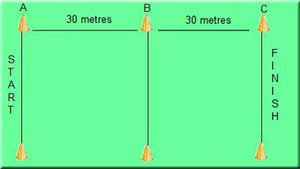

Flying 30 metre Test
Testing and measurement are the means of collecting information upon which subsequent performance evaluations and decisions are made. In the analysis, we need to consider the factors influencing the results.
Objective
To monitor the development of the athlete's maximum sprint speed.
Required Resources
To conduct this test, you will require:
- Flat non-slip surface.
- Cones.
- Stopwatch.
- An assistant.
How to conduct the test
This test requires the athlete to sprint 60 metres.
- The athlete conducts a warm-up for 10 minutes.
- The assistant marks out a 60-metre straight section (AC) with cones and places a cone at the 30-metre point (B).
- From a sprint start with appropriate start commands (on your marks, set, "GO") from the assistant, the athlete sprints the 60m.
- The assistant starts the stopwatch with the command "GO".
- The assistant records the time the athlete's torso crosses the 30-metre point (B) and the 60-metre point (C).

Analysis
The test result is analysed by comparing it with the athlete's previous results for this test. It is expected that the analysis would indicate an improvement in the athlete's sprint speed with appropriate training between each test.
Target Group
This test is suitable for sprinters but not for individuals where the test would be contraindicated.
Reliability
Test reliability refers to how a test is consistent and stable in measuring what it is intended to measure. Reliability will depend upon how strictly the test is conducted and the individual's level of motivation to perform the test. The following link provides various factors influencing the results and test reliability.
Validity
Test validity refers to the degree to which the test measures what it claims to measure and the extent to which inferences, conclusions, and decisions based on test scores are appropriate and meaningful. This test provides a means to monitor training on the athlete's physical development.
Advantages
- Minimal equipment required.
- Simple to set up and conduct.
- It can be conducted almost anywhere.
Disadvantages
- Assistant required to administer the test.
Free Calculator
- Flying 30 metre Test Calculator - a free Microsoft Excel spreadsheet you can download and use on your computer.
References
- CHU, D.A. (1996) Explosive Power and Strength. Champaign: Human Kinetics
- DAVIS, B. et al. (2000) Physical Education and the study of sport. 4th ed. London: Harcourt Publishers. p. 125
- DICK, F. (1987) Sprints and Relays. 5th ed. London: BAAB. p. 22-23
Page Reference
If you quote information from this page in your work, then the reference for this page is:
- MACKENZIE, B. (1999) Flying 30 metre Test [WWW] Available from: https://www.brianmac.co.uk/flying30.htm [Accessed